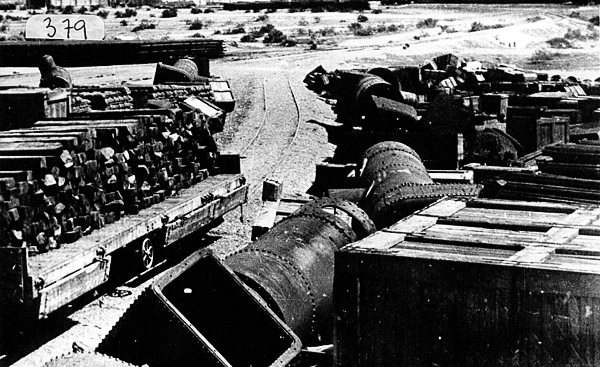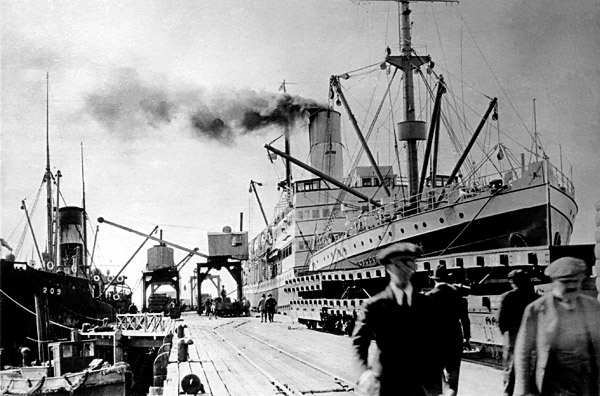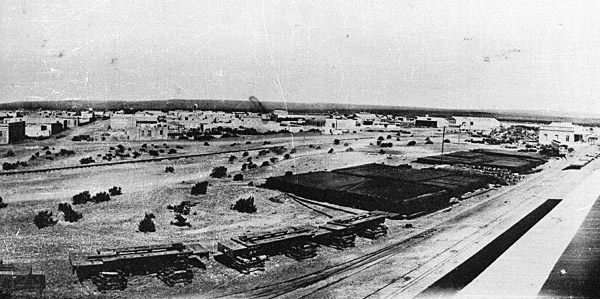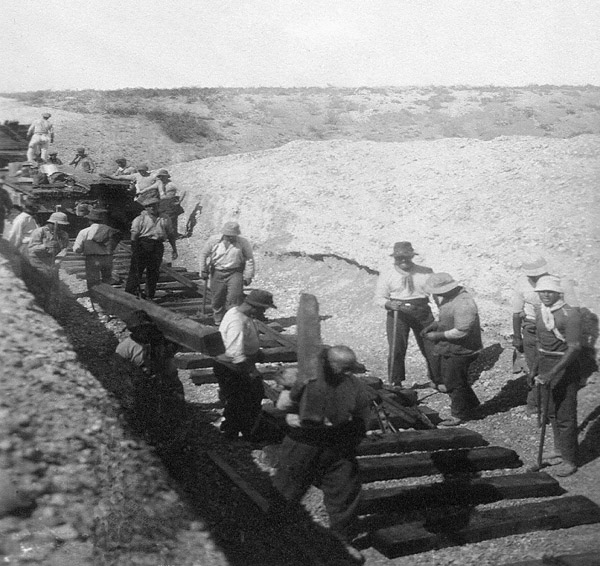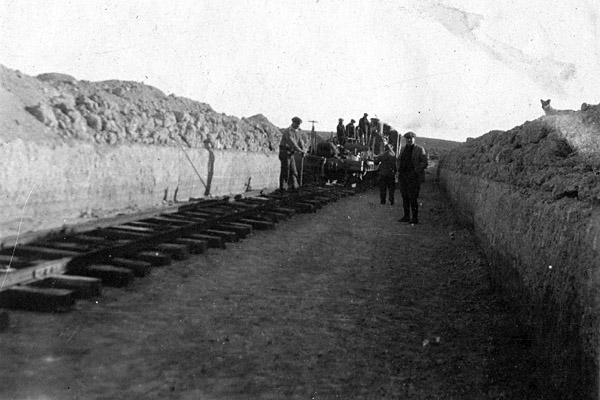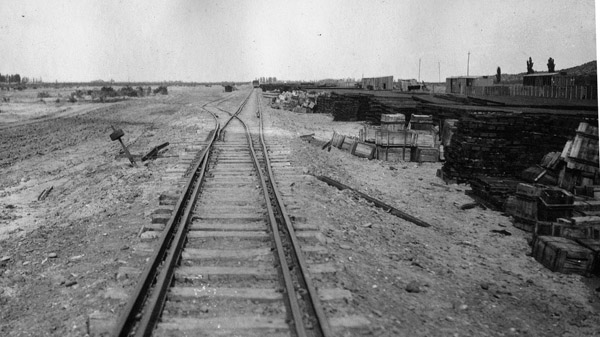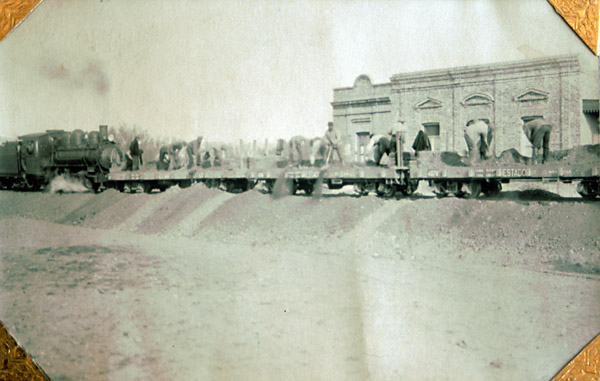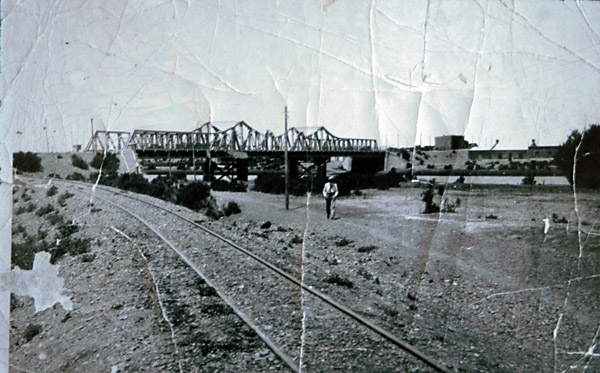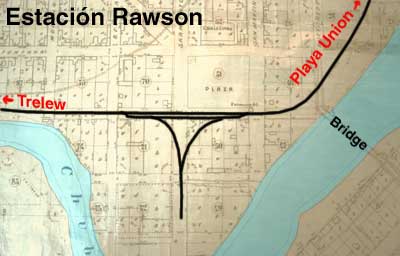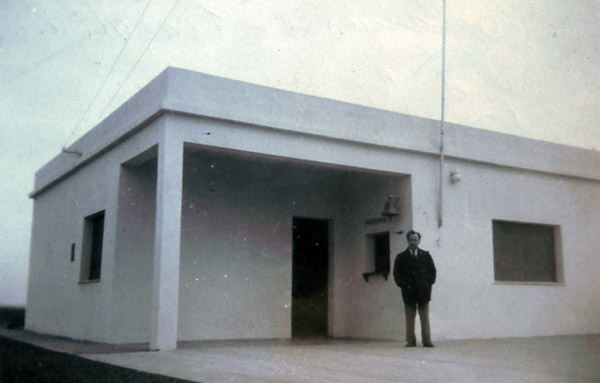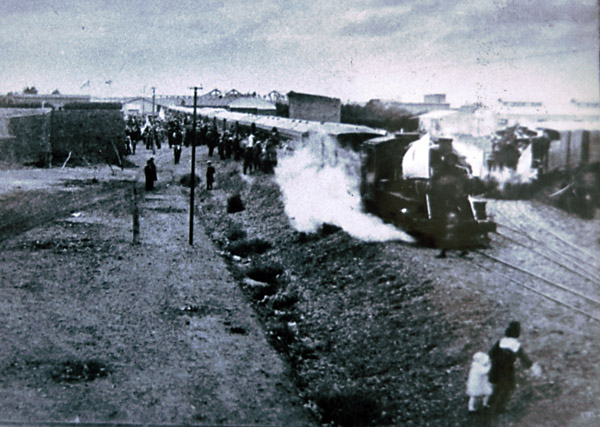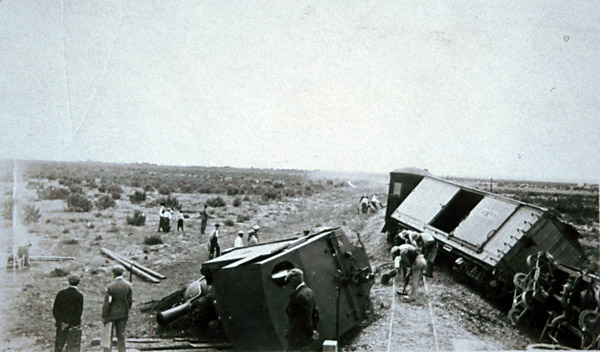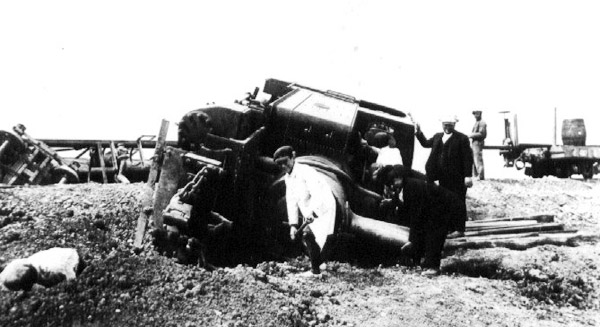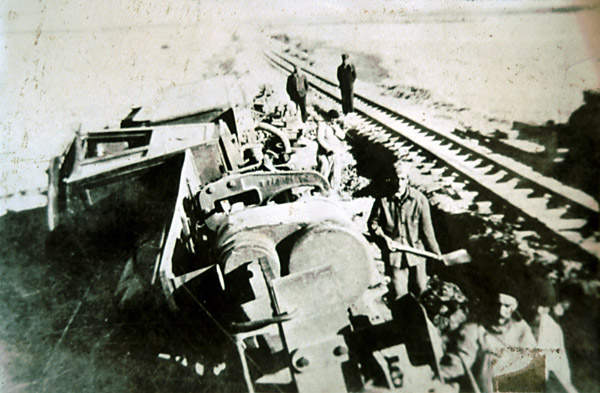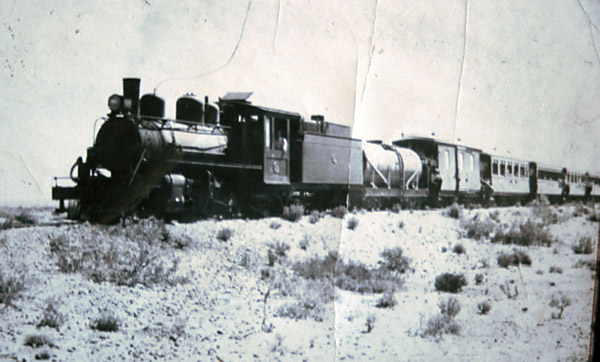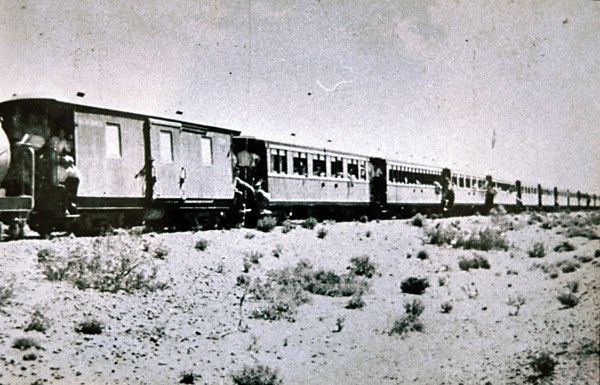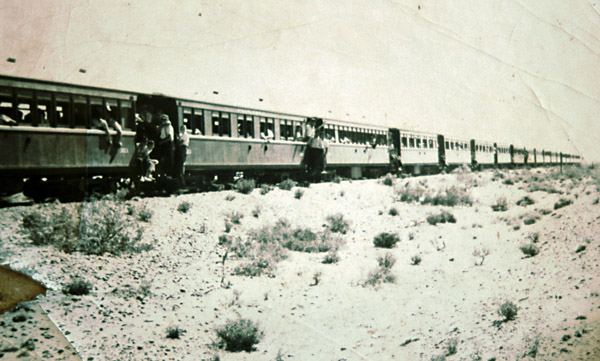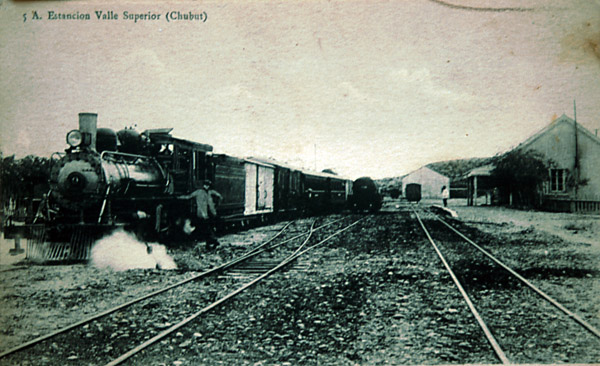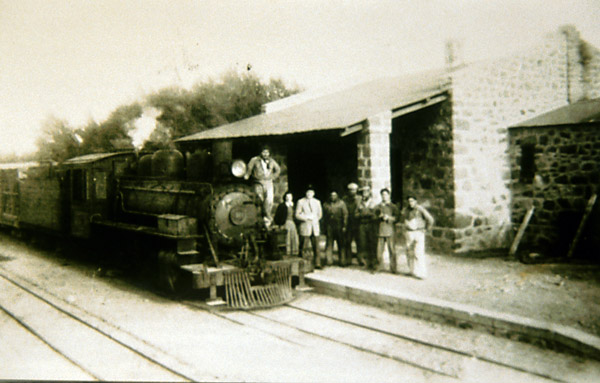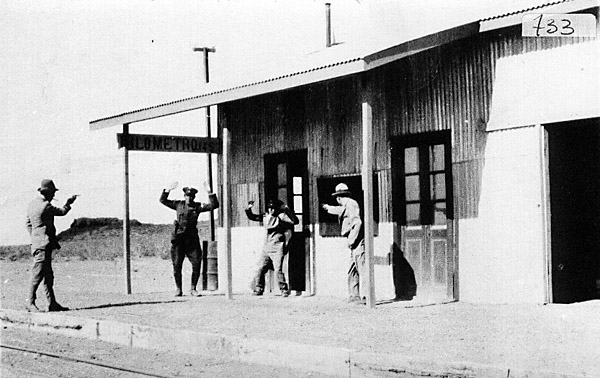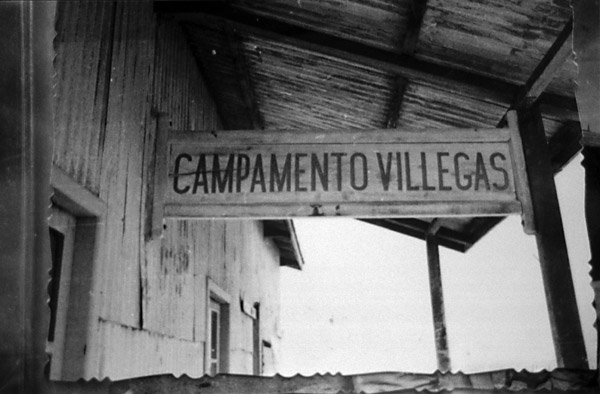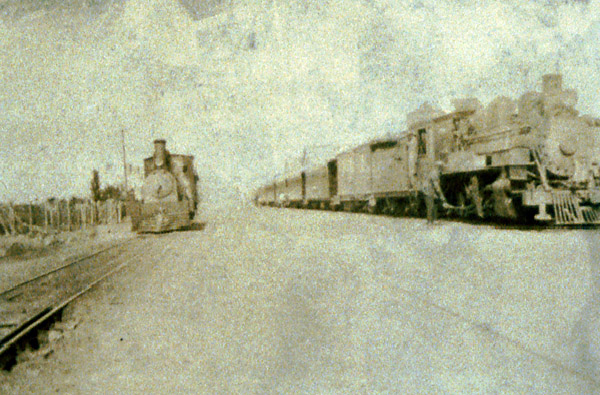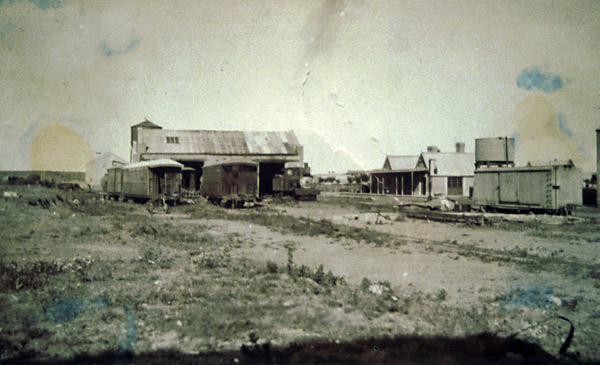 |
||||||||||||||||
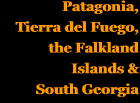 |
||||||||||||||||
 |
||||||||||||||||
 |
||||||||||||||||
A change of gauge, and new destinations Puerto Madryn in late 1922 must have been a busy place, for all the engines, stock, rails and sleepers for the new network were arriving by sea, to be stored on quickly-laid sidings. Seventy-five locomotives, 100 coaches, and 750 or more wagons must have been an impressive sight - like Barry Docks for a British enthusiast, but all narrow gauge and all brand new! There exists a photo showing a line of new Henschel 2-8-2s all mounted on metre gauge wagons and hauled by metre gauge 2-6-0 No. 3 - on their way from point of erection to a storage siding in Trelew. Crates of parts, wagons of sleepers, and Baldwin boilers dumped by the trackside; the scene at Puerto Madryn in 1922.
New 75cm. gauge works A shipload of Famillereux wagons chassis (identifiable by the body upright pockets along the sides) are brought ashore on metre gauge flats.
The stockpile builds up at Puerto Madryn. Visible are Henschel loco underframes supported on piles of sleepers, with rail stacks off to the right.
Laying wooden sleepers, probably west of Dolavon.
Track being laid in a newly excavated shallow cutting.
At first sight the two single point blades look like a recipe for disaster if wrongly set. However the rod at an angle with a bob near the top is a clue. The two blades are linked together and to this rod which acts to hold the blades in whichever direction they are. The leading wheel of the train approaching a blade set against it will move the blade, which will tip the rod and its balance weight over to change the next blade to the correct position and hold it there.
A ballast train hauled by a Baldwin.
The branch to Rawson & Playa Union The track runs through Rawson close to the river and past the north end of the road bridge. The bridge continues to carry traffic to this day.
There were no major civil engineering feats, the whole line being on the level valley floor. Three unmanned halts ('apeaderos') were designated in the 19km. distance to Rawson, and there was another 6km. of track on to the terminus at Playa Union. A simple passing loop and turning triangle comprised the layout at Rawson.
The station building at Rawson was fairly basic.
The photo below was taken at Rawson station, possibly on the opening day, 17 November 1923. The cameraman was facing east. There are two trains both hauled by Baldwin 2-8-2s and both decorated with flags. The left hand one is on one of the two through lines whilst the right hand one stands on the turning triangle.
It seems that the branch was sometimes worked by one of the two Henschel 0-6-0 tank engines (Nos. 19452 and 19453). The picture below shows one of these, again on some sort of special occasion. Note that whilst the tank wagon and bogie van are both 1922-built 75cm gauge stock, the passenger car is an old metre gauge 2nd class coach (No. 4) from 1886 converted by placing it on new 75cm. bogies.
On one occasion one of the 0-6-0Ts seems to have come to grief! The next two pictures show it 'in the dirt'. These photos are copies of those in Rawson museum and it seems likely that the accident was somewhere on the branch.
Another accident involved the overturning of one of the Baldwin 2-8-2s. There is no proof that this was on the Rawson line, but the original picture suggests that the left side of the track was flooded; The branch being largely on flat ground it seems quite likely that this was the location.
A set of three photos in Rawson museum recall the operation of an enormously long excursion at some point. Again the location is uncertain but the branch is the only line flat enough for a single Baldwin to cope with eighteen or more carriages! It would be nice to know the event which led to the running of this record-breaking train.
1 - The locomotive..
2 - tank car, furgón, and...
3 - about eighteen coaches!
The extension to Playa Unión had no regular passenger service, this stopping at Rawson. However, there were weekend excursions to the beach and some of the trains illustrated above may have been on such duties. Branch Line to Rawson Muelle It started in 1932, but most of the action was in the second half of 1933. In January 1932, the Governor of the Territory of Chubut asked the FFCC del E head office in Buenos Aires to contribute towards the provision of a railway to serve the existing muelle near the mouth of the Río Chubut. The reply to this request was basically “no way”. In July of 1933 Buenos Aires Senior Management authorized the local manager at Puerto Madryn to build a branch line to serve the muelle. He met the Governor of the Territory, and agreement was reached to build the line. The District Engineer was given the job of designing and estimating it, which he did, and submitted his proposal to the Manager at Puerto Madryn, who proceeded to authorise him to get on with the work. He started work at the end of October. The proposal which had been accepted involved most the branch being laid along the carriageway of a road which the Territory had built in 1931 to give good access to the muelle. The carriageway was 7 m. wide, and the railway was to occupy 2 m., thus leaving 5 m. for traffic — quite inadequate for two way traffic! Work was ongoing on the formation of a transfer yard at the junction, and about a kilometre of track had been laid along the branch when the whistle was blown by the local Head of the National Roads Authority, who complained to the District Engineer at Comodoro Rivadavia about what was going on. It would appear that the complaint was relaid to Buenos Aires and the Audit Office investigated. The Audit Office acted at once by suspending all work on the branch beyond where the rails had reached, and diverting the labour force on to lifting the track already laid to final level in the yard and on the branch, while they investigated. The road was to be widened where the track had already been laid. Possibly this involved slewing the rails on to the verge. Apart from the unsatisfactory arrangements on the road, the terminal yard at the muelle would have been unworkable; there was no agreement as to ownership and use of the muelle; no agreement to take over or use the existing decauville track on the muelle; no agreement to transfer fiscal land to the railway had been made; there were no cost headings established to which the work could be charged (it had been charged to maintenance of the line). The Governor had made prisoners available to do some of the manual work; one wonders if there might not have been irregularities here as well. Audit Office concluded their letter by asking the General Management to consider whether the project should proceed, and if so, to have undertaken the necessary negotiations and allocate the necessary funds. We don't know what happened, though the evidence from station arrangement sketches in the 1950s is that it was not completed and that the track in the junction yard had been lifted. The extension westward toward Colonia 16 de Octubre The new alignment started from Dolavon, the FCCC's 1915 railhead. There were no serious difficulties along the route, though steeper gradients west of Boca de la Zanja meant some wide sweeping curves to gain height. The layout of Dolavon at the closure in 1961 is easy to reconcile with the photo below. However, it was taken from a Chubut cadastral survey dept. plan, and track accuracy will not have been their primary concern. In any case I suspect that the loops in front of the station building may have been taken out later on.
Baldwin 2-8-2 no. 9 awaits departure with a down train from Dolavon - or 'Valle Superior' as it was originally known. The loco still carries its bell (behind the front sand-dome) which suggests an early date.
Another Baldwin, this time it is thought at Boca de la Zanja.
As in many areas of Argentina, new stations often are identified by their distance along the track, until at a later date a more imaginative name can be applied. In the picture below the staff of estación Kilómetro 145 seem to be enjoying themselves!
Km. 145 eventually gained the name 'Campamento Villegas', as seen here.
Further west at Las Chapas the route passed through an area of rich Kaolin (China Clay) deposits. Short branches were eventually built to access these pits, which produced the railway's most reliable traffic. The line eventually reached the high ground above the village of Las Plumas. It was here at Alto de Las Plumas in 1925 that work was halted by decision of the new Administrador General, Señor Enrique Pérez. Three years later work on the north-south line from Ing. Jacobacci ceased owing to a shortage of money. Whilst the latter line was restarted during the 1930s, no further progress was made beyond Alto de Las Plumas, though even in the 1941 timetable the route was still termed 'the line towards Colonia 16 de Octubre'. Regauging of the metre gauge. The original line from Puerto Madryn to Trelew was built on steel sleepers. These are normally pre-formed and punched at the factory to take rail clips or bolts and to hold the rail at a slight inward cant. It is therefore much more difficult to add a third rail. The original line therefore remained metre gauge for some considerable period until an extra rail was laid throughout by 1930, possibly by relaying with wooden sleepers. From 1931 the metre gauge stock was 'moth-balled' and the metre gauge presumably slowly removed (5). Two photos from the dual gauge period of the 1920s. On the right is a Baldwin 2-8-2 probably heading west out of Trelew station with a train for the upper valley. On the left is one of the two metre gauge Fives Lille 2-6-0s bought second-hand from the FC Central Norte.
A second picture of Trelew in mixed gauge times. Most of the stock on show is newly-built Famillereux material from 1922, but the locomotive is one of the original metre gauge FCCC 2-6-0s.
List of places and facilities Resources 23-2-2018 |
||||||||||||||||
Chapter 7
The 1922 75cm gauge empire


Main pages
Railcars •
Esquel route construction photos •
Com. Rivadavia to Punta Piedras •
More photos at Com. Rivadavia •
Appendices
9 Track layout photos at Ing. Jacobacci •
